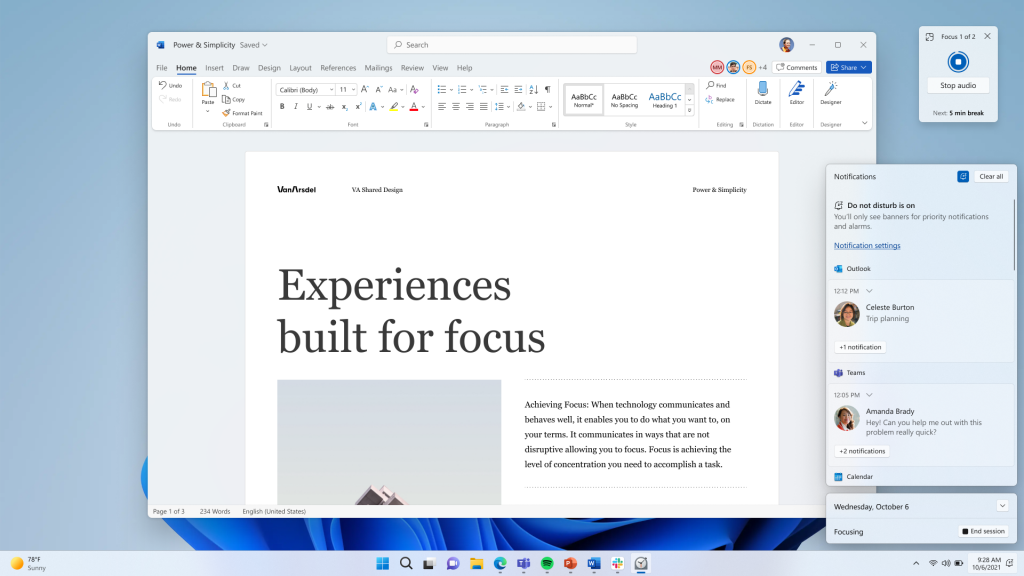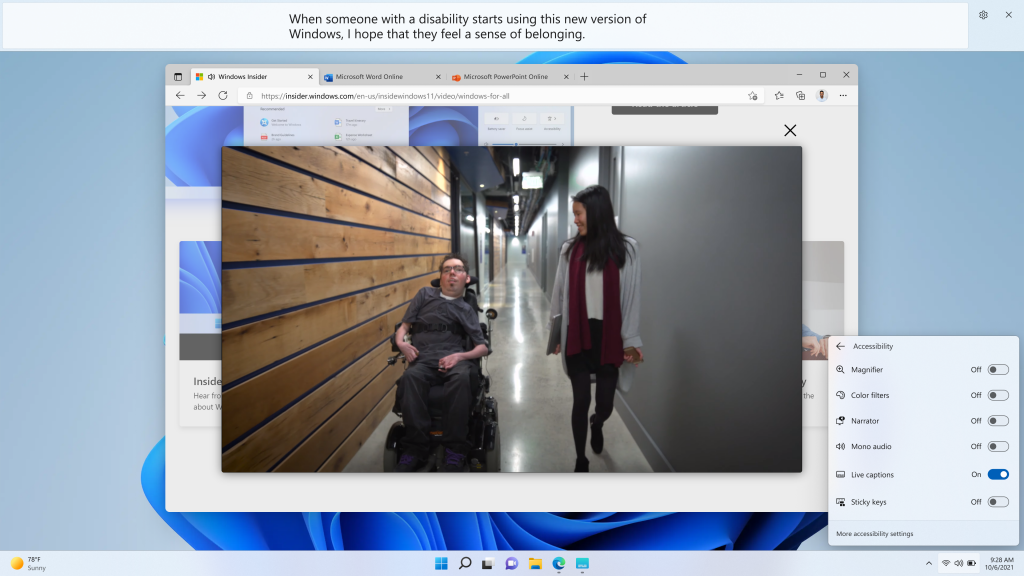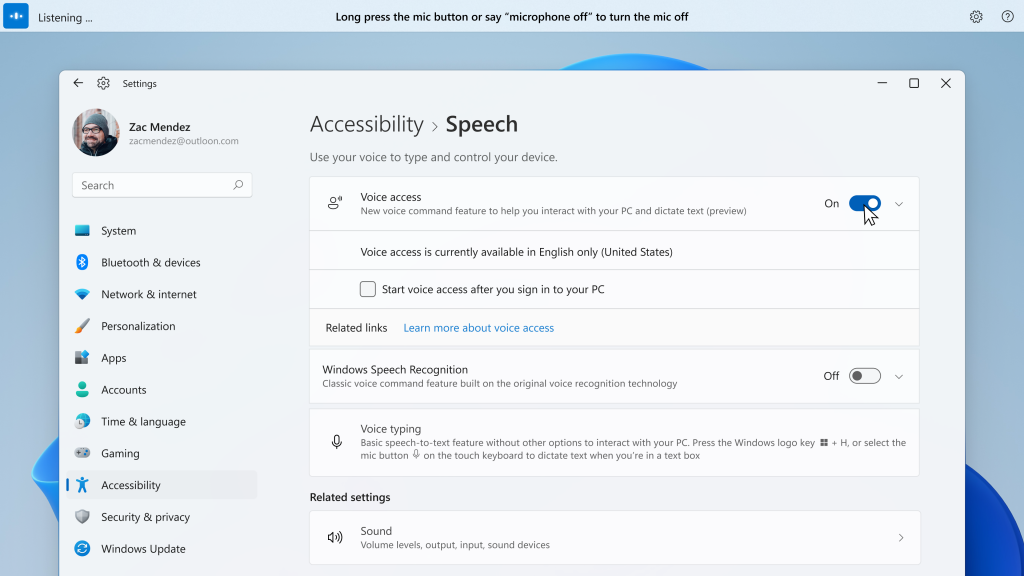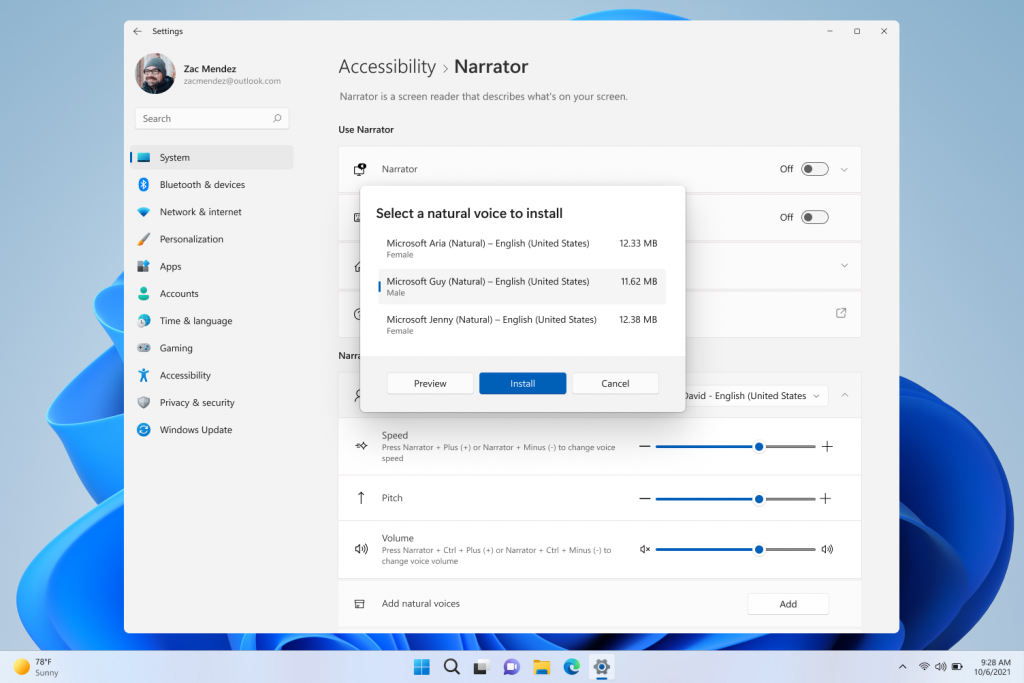New accessibility features coming to Windows 11
Last year, Microsoft renewed and strengthened its commitment to closing the disability divide; to work toward improving educational and employment opportunities for people with disabilities around the world. And that commitment has been central to the development of Windows 11: the most inclusively designed version of Windows yet.
At its launch last fall, Windows 11 included a whole host of accessibility improvements designed for and with people with disabilities: calmer, more appealing sound schemes; beautiful new contrast themes and closed caption customizations; a more responsive and flexible experience for working with assistive technologies; and a new Accessibility Settings pane to make all of these features easier to find and use. And we’re continuing to innovate.
Windows 11 is the most accessible version of Windows yet
Today, we’re excited to take a deeper dive into four of the new inclusive experiences coming to Windows 11, some of which we introduced during last month’s Windows Powers the Future of Hybrid Work event: a more immersive Focus experience, system-wide live captions, more powerful voice access tools and more natural voices for Narrator. Let’s dive in.
Focus makes it easier for everyone to be more productive on Windows

The way we work has changed over the last few years. We’ve gained efficiencies, but also have a lot of information competing for our attention. New hybrid workstyles, online meetings and remote collaboration offer the potential for constant distractions and mental fatigue. This is especially challenging for people with ADHD. To help navigate this new way of working, we envisioned a new Focus experience with people with ADHD to help the ADHD community, and everyone, focus and do more. We made it simpler to control your notifications by adding an option to turn on Do Not Disturb, which reduces the number of notifications that can distract you. Do Not Disturb announces priority notification and alarms, and Action Center tracks all your notifications, so you can have confidence you are not missing important information.
And, we introduced Focus sessions, a new experience that uses proven techniques to build healthy digital habits and get more done. When you start a Focus session, Windows will turn on Do Not Disturb and turn off task bar badges. Focus is integrated with the Clock App. It launches a timer to help you focus and reminds you to take breaks, which is proven to improve productivity. It is integrated with Spotify, so that you optimize your environment with your favorite audio to get into and stay in the flow.
Live captions make it easier for everyone to consume audio content

So many people benefit from captions on audio content: people who are deaf and hard of hearing, non-native language speakers, if you’re in a loud or quiet room, and more. With system-wide, on-device live captions coming to Windows 11, speech to text will be available in so many more contexts than before. We envisioned live captions with people who are hard of hearing and people who are deaf to enable them, and everyone, to consume audio content on Windows. Live captions on Windows 11 can automatically transcribe spoken content from any audio, including from applications like Microsoft Edge and even from microphones – which means you can get captions for a live, in-person conversation!
It’s available now for Windows Insiders. You can find live captions from Settings > Accessibility > Captions or from Quick Actions > Accessibility. Unlike most closed captions, which appear at the bottom of the screen, live captions on Windows 11 run along the top, right under the camera on most systems, which makes it easier to follow the captions while continuing to appear engaged in remote meetings – but they can also be moved to the bottom or into a floating window if you’d prefer. The captions were designed to work with other windows, so that they don’t occlude app content. They can be personalized with different fonts, font sizes and colors.
Importantly, live captions on Windows 11 leverage state-of-the-art speech recognition while staying completely local to your device. This means that once they are set up, they are always available, without an internet connection; they are instantly responsive; and they can be trusted to respect users’ privacy because they are generated on device, and don’t send any content to the cloud. Live captions are available with support for U.S. English.
Voice access makes it possible for everyone to control their PC with their voice

Many disabilities – and many circumstances – can make it difficult to use a keyboard and mouse. We envisioned a new voice access experience with people with limited mobility, e.g., people with mild-severe arthritis, cerebral palsy and other conditions that make it difficult to use a keyboard and mouse, to make it possible for them, and everyone, to command and control their PC and to author content in any application using their voice. For example, voice access supports scenarios like opening and switching between apps, browsing the web, and reading and authoring mail.
Voice access is available now for Windows Insiders. You can find voice access in Settings > Accessibility > Speech. When you turn on voice access for the first time, it will prompt you to download a speech model for the on-device speech recognition. Once it is downloaded, you can choose which microphone you want to use with voice access and start using your voice to control your PC.
To help get you started, voice access includes an interactive guide that explains how to complete common tasks using your voice. You can also access a complete list of commands by asking “what can I say?” when voice access is listening. Voice access even gives real-time feedback of what it heard so that you know which word was not recognized correctly when it makes a mistake.
In addition to navigating and interacting with Windows, you can emulate standard inputs like keyboard and mouse with your voice using the grid and numbers overlays, so you can access content in any app or web page. You can even dictate and edit text with voice access.
Like live captions, voice access leverages state-of-the-art speech recognition directly on your device – which means it too is available when you’re offline, responds instantly and keeps your data on your machine. Voice access is available with support for U.S. English.
Additional information, including an introduction to common voice commands and the complete set of supported commands, is available in this voice access commands list.
Natural Narrator voices make it delightful for people who are blind to consume content

Finally, we are excited to announce the availability of natural voices for Narrator. One of the top pieces of feedback we have from our customers on the Narrator experience is that our current voices are not great to listen to. Especially for cases when you may want to read an article or extended text. To address this feedback, we are bringing natural voices for Narrator to enable people who are blind or with low vision to enjoy scenarios like browsing the web, reading, authoring mail and more.
Natural Narrator voices leverages state-of-the-art text-to-speech on device with Windows. Once set up, the new voices are always available (without an internet connection), instantly responsive and can be trusted to respect users’ privacy because text to speech is processed on device, without sending information to the cloud. Narrator natural voices are available with support for U.S. English.
Try Windows 11 and give us feedback
Windows 11 continues our journey to empower every person on the planet to achieve more; to empower people with disabilities to cross the digital divide at school and work. Importantly, we are designing inclusive Windows experiences both with and for people with disabilities. And we all reap the benefits. We are leveraging state-of-the-art technology to deliver experiences that are accurate, natural and delightful. Still, we recognize we have much more to do.
Preview builds of Windows 11 with all of these experiences are available now to Windows Insiders. As you try these features out, please let us know what you think. Whether you’re using an Insider build, or a generally available version, Windows makes it easy to share your thoughts and suggestions — just press the Windows logo key + F to launch the Feedback hub and share what’s top of mind. We’re excited for your feedback.
Finally, if you are a customer with a disability and need technical assistance, the Disability Answer Desk is there to assist via phone (800-936-5900) and chat. In addition, we also have an ASL option available for our customers who are deaf or hard of hearing in the U.S. (+1 503-427-1234). Please contact us, we are always happy to help.
Source: New accessibility features coming to Windows 11






Leave a Reply